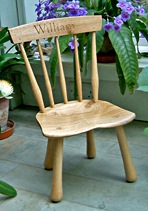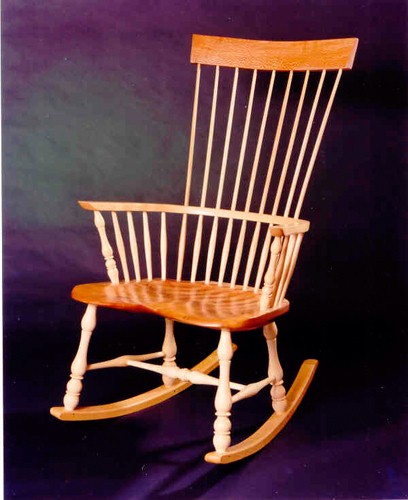
| |
| Home |
| About Nick & Kathleen |
| Greenwood working |
| Chairs |
| Childrens chairs |
| Stools |
| Benches |
| Tables |
| Treen |
| Contact us |
| Links |

Review of
a Katie Abbott contemporary windsor chair.
Dr. B.D.Cotton

Of the many challenges which Regional Furniture Studies faces into the future, I feel that there is perhaps no more pressing need than to form bridges between its own study of regional design differences, the use of native woods and the multitude of problem solving devices which one encounters from area to area; and the real benefit which a knowledge of these traditional forms can have for the enrichment of contemporary furniture making. It was with great pleasure, therefore, that I accepted an invitation to spend a day with the Pole Lathe Turners Association Show and AGM at Westonbirt Arboretum in May. One of my tasks was to choose an item made and exhibited by one of the members for discussion at the dinner in the evening. (Appropriately, Bangers and Mash followed by bread-and-butter pudding was served!) There were many excellent and innovative chairs, stools, and other woodwork presented, but my own personal choice was a rocking chair, illustrated here, made coincidentally by an RFS member, Katie Abbott. The more that I engaged with Katie’s chair, the more complex and interesting it came to be, for it is multilayered in terms of its cultural and craft design references, which were apparently effortlessly fused together to make an extremely satisfactory, contemporary chair. My analysis of the chair naturally took in the primary issues which accomplished chairmakers prize - those of technical expertise and the ‘right for purpose’ test of sitting in the chair and allowing the body to react to it in a purely sensual way. As the illustration shows, the technical quality of the turnery work is consistent, crisp, and with well observed profiles, all of the highest quality. This is combined with a perfectly steamed and bent arm bow, through which nine tall back spindles pass, and which in turn are topped with a classic simple curved comb rail. The seat is elegantly sculpted to provide strength and comfort, but with deeply chamfered lower edges which create an illusion of the seat being thinner than it actually is. The legs terminate in flattened sawn rockers, which at first appearance are inelegant in design, but which on further examination have been made in this way to prioritise maximum stability in use. The comfort level and use as a rocking chair are perfectly in balance. All of this is merely to give a superficial sense of the chair, and it is at the level of connotation that Abbott’s work becomes an exciting synthesis of ideas. Firstly, she has worked both inside and outside the historic conventions which govern wood use in Windsor chairs. She only progresses ideas where they will not harm the structural function of the chair, and where breaking with convention will supply a new sense of decoration, using grain patterns. Ash, the principle chair turners’ wood, is used throughout the turned work. Its clean, unoxidised or stained appearance gives a contemporary sense of a light, open structure with clean, natural colour and grain. The chair cleverly moves from the shaping of the legs, stretchers and under-arm turnings as prominent decorative devices which draw the eye towards them, and then contrasts and dampens any sense of excess with the simple, even austere turnings of the back spindles. In this, the chair exhibits the first of many antithetical devices, or contrasts, which create both ambiguity and its resolution as a way of offering the chair as a narrative which can be read in a number of ways. Continuing in this vein, we then see that the chair is intersected with three dark brown horizontal layers which again present strong visual contrasts with the light upper and lower vertical components of the chair. The rockers, which are made from sawn Elm and are oxidised to a chestnut brown colour, form the lower layer. The brown seat and comb rail, in turn, provide the central and upper layers to the colour strata. The colour contrasts in the chair then move us further still, to consider the qualities of grain pattern. The tour de force is the daring use of Plane for the seat and comb rail. Both sections are quarter sawn to show the dramatic and intricate profile of the medullary ray, which gives the wood the well-earned title of ‘lacewood’. Abbott has brought much understanding of the historic uses of woods to her chair in choosing this particular timber, since although not used as a traditional Windsor chair wood, it was used, albeit sparingly, in furniture as a veneer wood particularly, and it was widely used in the interior fittings of London trains. Its inclusion here shows how an awareness of native timbers used elsewhere in historic furniture and fittings can find new uses and ways forward without compromising the structural integrity of the object. Interestingly, the sections of wood she has used for these parts are also cut on two different tangents of the quarter to provide different grain patterns in the two parts in a way which a few other contemporary furniture makers do, amongst which, David Linley, for example, on occasion effectively uses different quarterings to veneer different areas of his furniture. Finally, the design of this chair offers a further cultural awareness, that of Windsor chairs from two major traditions; those from Great Britain and those from America. That the British Windsor inaugurated the great traditions of America is undisputed. (See Goyne Evans American Windsor Chairs. Chapt. 1) However, American makers quickly innovated and produced their own designs and ‘signature’ devices. This chair cheerfully acknowledges that, and synthesises common American leg and under-arm turnings which contains a joke. The radical craftsmen who worked in America merely inverted and exaggerated the profile of the common British leg turning. The chair alludes to other aspects of American influence, too, in the slender sharply pomelled seat, for example. But certainly it has strong British connotations, and one feels that this chair would find a comfortable place on either side of the Atlantic. Ultimately, the success of the chair lies strongly in its capacity to conjoin two traditions within a successful contemporary reinterpretation of both. As will be clear therefore, I chose this chair for many reasons; because of its excellence in use and craft technique, but equally in the complex and intelligent sense of the way in which it explores both design and material use, which calls on many historic sources to re-create a new contemporary interpretation which is satisfying at both physical and intellectual levels. Katie Abbott has clearly learned much from Regional Furniture Studies, and her work offers an encouraging sense of how this subject area can be brought to the experiences of contemporary furniture makers for the benefit of all. Dr. B.D.Cotton
|